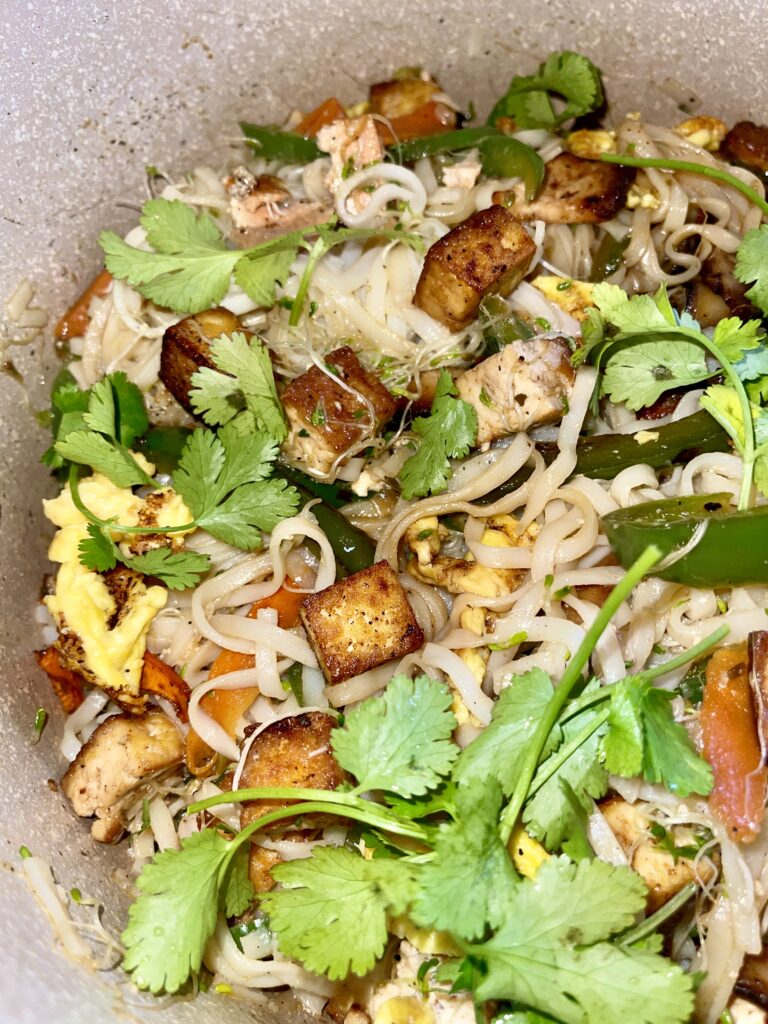What is Vegan Pad Thai and How is it Different from Regular Pad Thai? Our vegan version comprises of bell peppers, tofu, carrots and scallions.

What is Pad Thai?
Pad Thai is a popular Thai dish that consists of stir-fried rice noodles, eggs, peanuts, and other ingredients. It is one of the most popular dishes in Thailand and has become a global favorite. The dish is served with fresh vegetables, herbs, and spices to give it a unique flavor. Pad Thai can also be served with seafood or meat for added flavor. It is an easy-to-make dish that can be enjoyed as a main course or as part of a larger meal.
Veganism has gained significant popularity in recent years, with more and more individuals embracing a plant-based lifestyle. One dish that has become a staple in vegan cuisine is pad thai. This delectable Thai dish is traditionally made with a combination of noodles, vegetables, and protein. However, in order to cater to the vegan community, certain components need to be modified or substituted. In this essay, we will explore the key components of vegan pad thai, providing examples and arguments to support the importance of these substitutions.
Vegan pad thai is a plant-based version of the traditional Thai dish, which typically includes animal-based ingredients such as eggs, fish sauce, and shrimp. To create a vegan-friendly version, these components are replaced with suitable alternatives. This essay will discuss the three main components of vegan pad thai: noodles, sauce, and protein.
Components
- Noodles:
The foundation of any pad thai dish is the noodles. In the vegan version, rice noodles are commonly used as a substitute for egg noodles. Rice noodles are gluten-free and provide a similar texture and taste to the original dish. They are readily available in most grocery stores and can be easily cooked by soaking them in hot water. By using rice noodles, vegans can enjoy a delicious pad thai without compromising their dietary choices. - Sauce:
The sauce is a crucial element in pad thai, as it adds flavor and richness to the dish. Traditional pad thai sauce contains fish sauce, which is not suitable for vegans. However, a vegan-friendly alternative can be created by combining soy sauce, tamarind paste, lime juice, and a touch of sweetness from sugar or agave syrup. This homemade sauce provides the same tangy and savory taste as the original, without the use of animal products. - Protein:
In traditional pad thai, protein is typically added in the form of eggs and shrimp. To make the dish vegan, these ingredients must be substituted. Tofu is a popular choice for vegan pad thai, as it absorbs flavors well and provides a satisfying texture. It can be marinated and stir-fried to mimic the taste and consistency of eggs or shrimp. Another option is to use tempeh, a fermented soy product that offers a nutty flavor and a substantial amount of protein. These plant-based protein sources not only enhance the nutritional value of the dish but also contribute to its overall taste and texture.
Conclusion:
Vegan pad thai is a delightful and satisfying dish that can be enjoyed by both vegans and non-vegans alike. By making simple substitutions, such as using rice noodles instead of egg noodles, creating a homemade sauce without fish sauce, and incorporating plant-based proteins like tofu or tempeh, the essence of pad thai can be preserved while adhering to a vegan lifestyle. These modifications not only make the dish accessible to a wider audience but also showcase the versatility and creativity of vegan cuisine. So, whether you are a vegan or simply looking to explore new flavors, vegan pad thai is a must-try dish that will surely leave you craving for more.

How to make vegan Pad Thai
Veganize by substituting “Just egg” (vegan egg alternative) using tamari instead of fish sauce, and use tofu or mushrooms instead of seafood and fish. Make sure you got lots of herbs like scallions and cilantro to add some refreshing feel to the dish. Soak rice noodles for 10 minutes before cooking in boiling water. For the sauce I used bachans, vinegar and sugar. Used alfalfa sprouts instead of bean sprouts. Feel free to modify and get creative.







Steps
- Soak noodles for 10 minutes, cook in boiling water for 5 minutes. Run through cold water.
- Sauté, veggies and tofu searing and seasoning along the way.Add mixture of soy, sugar, vinegar & sesame oil to the sauté.
- Toss in noodles. Mix thoroughly.
- Make vegan egg, slice em up into strips and top it over the noodles along with some extra sprouts. We used alfalfa sprouts for this one.
Vegan Pad Thai
Ingredients
- 1 Piece carrot
- 3 Stalks scallions
- 1 block tofu
- 1 Piece bell pepper
- 1 Bag sprouts I used alfalfa, worked out ok too
- 1 Bunch cilantro
- ½ Cup vegan egg just egg is the best out there
- 5 tablespoon sesame oil
- 1 tablespoon sugar
- 3 Tpsp soysauce
- 1 tablespoon vinegar
Instructions
- Soak rice noodles for 10 minutes. Cook for 5 minutes in boiling water. Rinse and run through cold water. Toss in sesame oil and season if you please.
- Sauté cut up veggies, feel free to use whatever you have on hand. Drizzle a little sesame oil too. In a separate non stick pan; Pan fry tofu, turning ever so carefully, seasoning as you go, set aside then cook vegan egg in non stick pan and cut up into strips. Set aside
- Make sauce by mixing sugar, soy and vinegar. Stir it in your sautéed veg.
- Toss in noodles. Mix thoroughly. Top with sliced vegan egg, tofu, sprouts and herbs (cilantro).






Comments
No Comments